#bear peter in a goth fit >>>>>>>>
Text
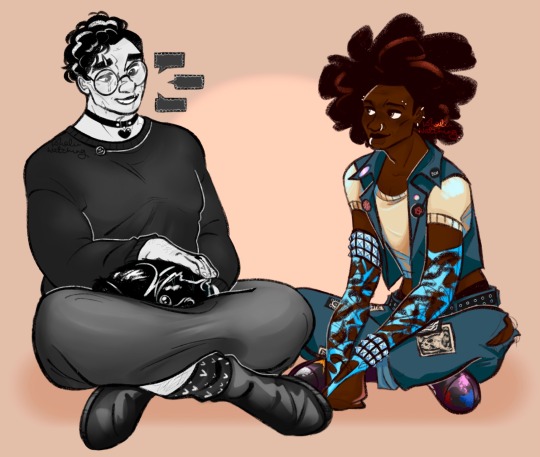
dumbasses ft daughter in the modern era
#spider man: across the spider verse#spider punk#spider noir#hobie brown#noirpunk#and#DING DING#its her everybody its the star of the show#she's such a little nightmare cat#peter's so inordinately fond of her it's stupid <3#(this is how all cat owners are)#me posting an HOUR EARLY??? no way#this one's a bit bland but i like the cleanness i guess#and look this time i remembered my fucking watermark#peter's tiny speech bubbles are supposed to wink at silent movie caps#thanks ken! im stealing your genius#bear peter in a goth fit >>>>>>>>#technically he's supposed to be in color here but trust me nobody wants to see that shit lol
263 notes
·
View notes
Text
Some Cyberpunk NPC Fashion Headcanons: Misty, Judy, and Panam
Okay, so this has been burning in the back of my brain for five thousand years- as an unfashionable fatass loser who loves the idea of clothes and style in theory, I project this love onto fictional characters. Mostly my oc, but also canon characters. So, of course in game characters wear one outfit but I've developed kind of my own idea of what their style would be based both off those canon outfits and the vibes I get~
If you disagree, that's your business- but I'm having fun with the barbie dolls rn.
Misty- Cozy quirky goth gf
dresses in quirky goth fashion or like a victorian ghost, no in between
eclectic as fuck
cozy sweaters are always a favorite though
dresses with peter pan collars, i have no explanation, i just feel it
those kitschy chunky earrings that are like little raisin boxes or like weird clown babydolls
general kitsch touches, she likes things a little weird, keeps life interesting
**crystals~**
definitely has a purse or bag with thousand of weird little pins and keychains- she sees the value of minimalism but she just loves weird cute little things
fishnets and different patterned tights
weird chunky boots
Examples:

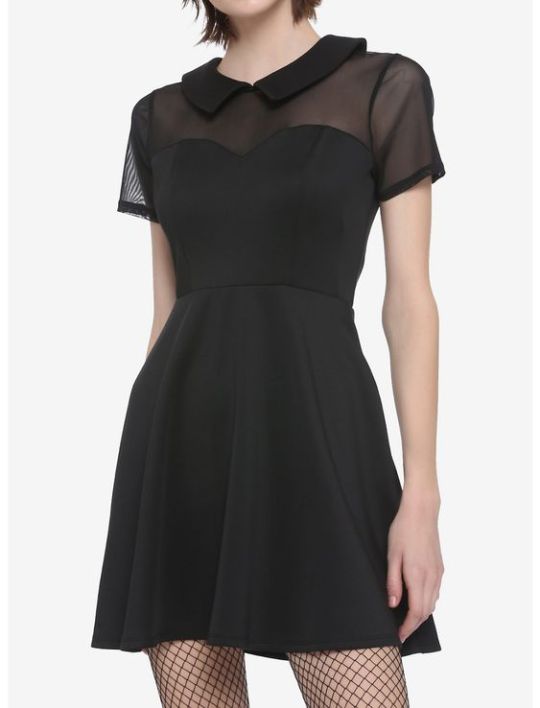
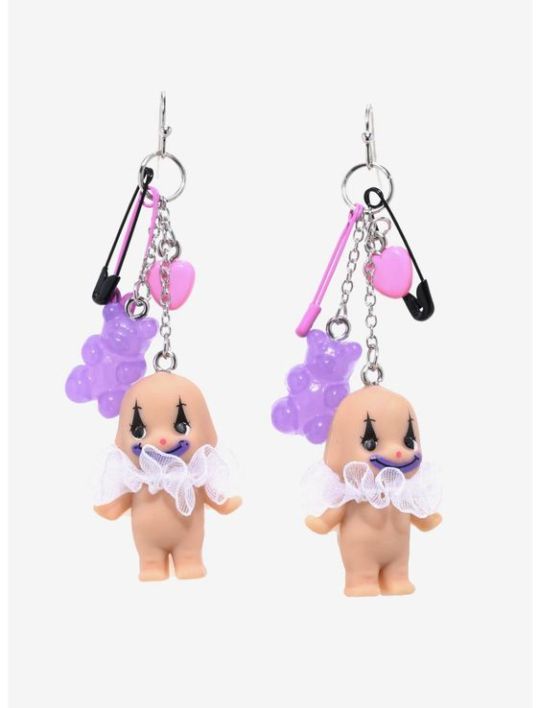
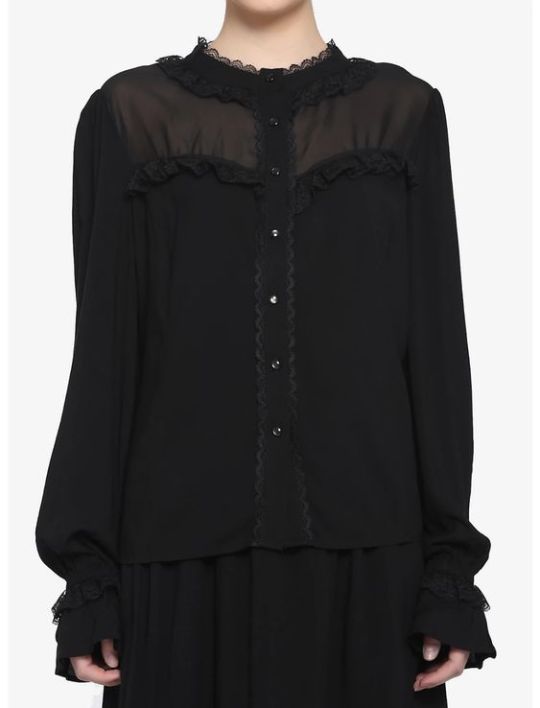


Judy- Punk contrast techie
shorts and overalls obviously, always with a strap undone for the aesthetic~
idk why but i just get the vibe she loves asymmetry- one shoulder, asymmetrical cut out, fuck yeah
and like contrasting patterns and stuff, like shorts and pants with mismatching legs
i see her in bright plaid punk pants, it just fits the vibe, don't ask me why
crop tops more often than not- likes showing off her tattoos
bushido merch
not a big jewelry gal but she likes a fun belt
has to have pockets- do not get her on the topic of non-functional pockets
feel like she probably has tattooed on eyeliner, not her full eyeliner look is tattooed- but like a base layer of it is
has band merch shirts and clothes too for sure, she's passionate about her interests and will wear them with pride
Examples:
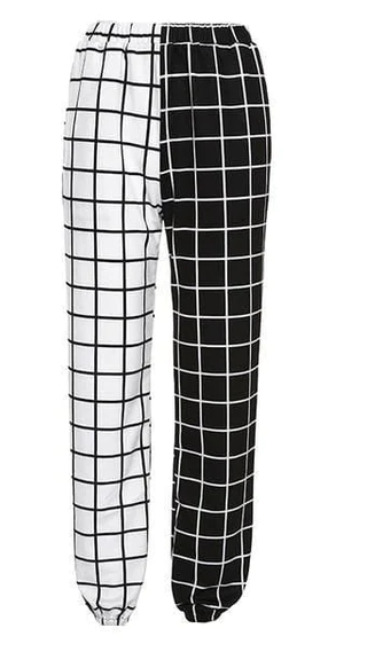
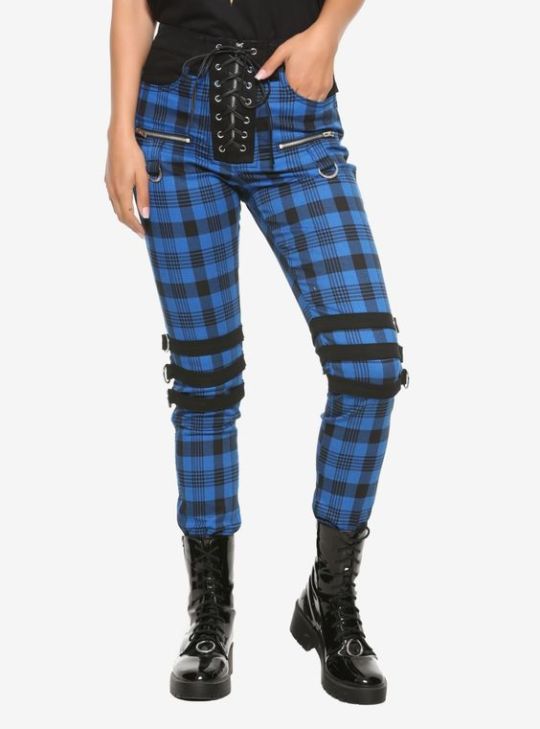


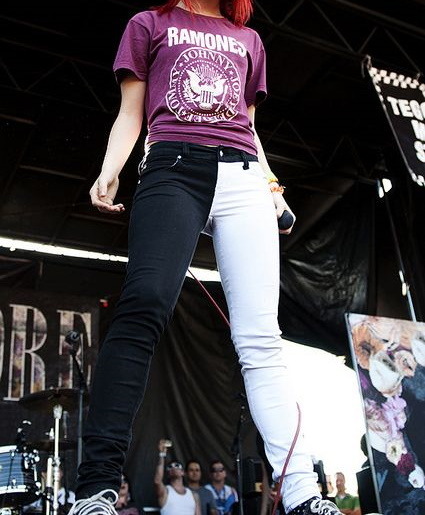

Panam- Nomad tomboy gremlin
fashion isn't exactly a huge priority in the nomad world, but Panam still has her taste- notably her love of bodysuits
also does love the off the shoulder look- but finding bras that work with it and her tits is the bane of her existence
Bras are generally the bane of her existence- you wanna hear a rant ask this woman about having the underwire snap in her last good bra and stabbing her in the tit when she's 4 hours into a 12 hour drive and miles away from civilization
cargo pants, torn jeans, and ratty shorts
so many of her clothes are torn
tattered old crop tops and tanks
almost always has her aldecaldo jacket thrown over whatever she's wearing- even if it clashes
also not a big jewelry person, just not super practical- her and a friend in the clan tried to piece their own ears when they were kids and all they did was earn themselves some nasty infections
this girl has camo pants, idk if that's my brain associating her with 6th street from that one gig or the connection between aldecaldos and vets- this girl has camo pants
more of her clothes are stolen from other aldecaldos than she'd care to admit
Examples (ignore the jewelry in some of these):
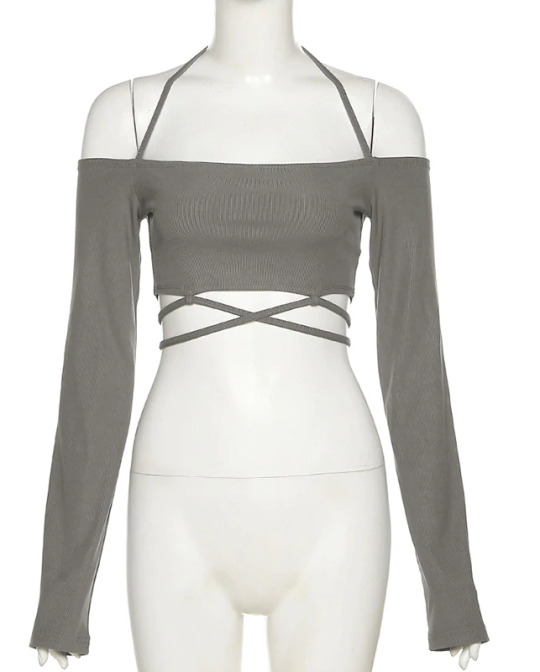



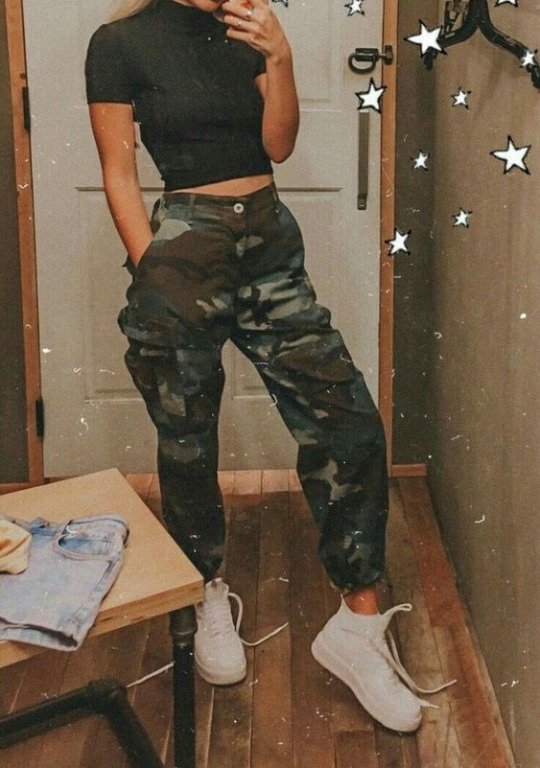
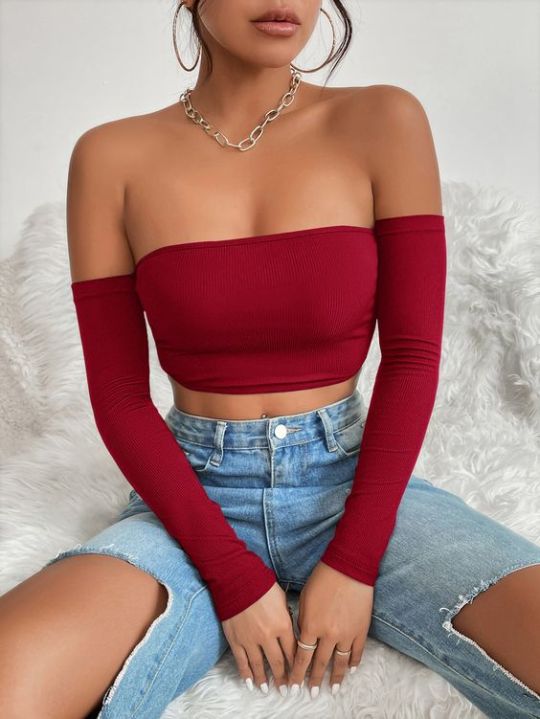
Bonus Round:
My V (Aidan Becker)- crouching punk hidden pastel
leather jacket 9 times out of 10 (definitely stole it off a corpse)
black crop tops, stomach almost always showing
ripped pants and shorts, often with fishnets beneath
subtle hidden touches of cute stuff, like she'll take off her combat boots and have pink heart socks on beneath
skirts when she's feeling fancy or slutty
flannels for pops of colors occasionally
if she's not one arm raise away from flashing her tits- whats the point?
only wears bras if they're meant to be seen
bright blue nail polish always
teddy bear hoodie when she's home alone and vibing- very few have seen it, embarrassed by it- but it's very cozy
Examples:


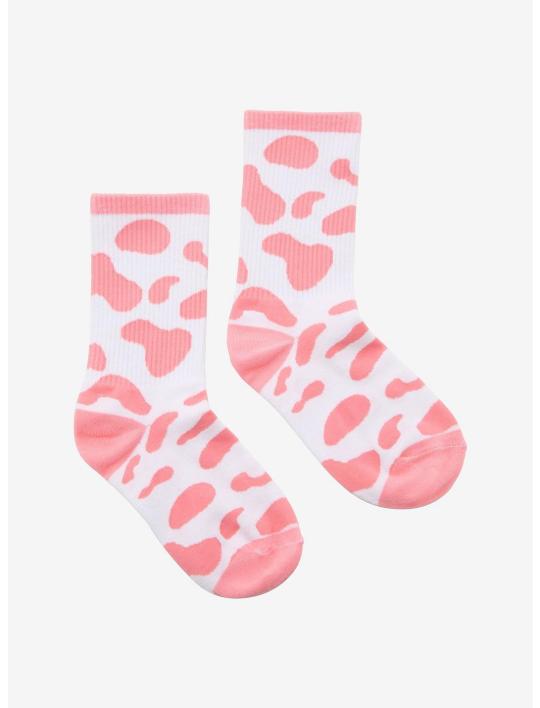

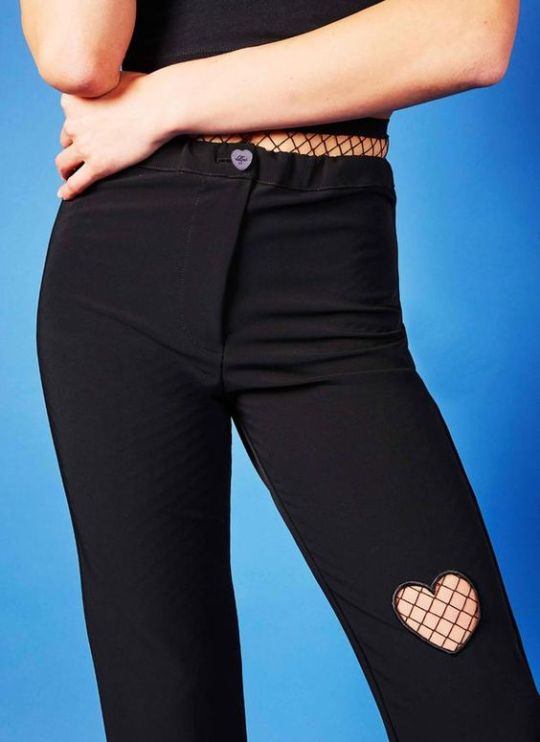

#cyberpunk 2077#cp2077#misty olszewski#judy alvarez#panam palmer#yes including my v was incredibly self indulgent#no i dont care#don't know if i'll do the men since like kerry has dramatic punk rocker fashion johnny who has a more casual punk rock#then fucking river who probably buys though 5 packs of mens tank tops from the dollar store and calls it good#like we got two punk rockers and a quote unquote straight man in an ugly jacket so not quite as much variety to dig into#anyway it was 3 am and i was bored have my stupid thoughts
22 notes
·
View notes
Note
Please give us your 001 thoughts for Wacky Races!!
Oh so sorry I didn't get any notification for your ask !
Oky doky know that I will not count Scoob!, Dastardly and Muttley and Wacky Raceland because they are their own continuities, BUT I WILL count in your ask Wacky Races, Dastardly and Muttley in their Flying Machines, Magnificient Muttley, The Perils of Penelope Pitstop, The Mumbly Show, Laff-A-Lympics, Fender Bender 500, Yogi's Treasure Hunt, Yo Yogi, Wacky Races Forever, the 2017 Wacky Races reboot and of course every comics and merch taking place in those shows as the same universe so expect me to be VERY wide
Favorite character: until watching the reboot, of course it was Dick (my favorite animated versions being Flying Machines Dick/Dick the 1st and WRF Dick/Dick the 4th) because he is of course a glorious bastard we can't help wishing he would win, but my favorite character of the reboot is Pandora becaus she is basically a female Dastardly goth and hot and even meaner, so I would say the Dickss in general and Pandora Pitstop
Least Favorite character: I don't give a shit about most racers of the original show, I understand why they were not reused later on lol so flat, only Rex Max stood up more. Oh and the pirates from the reboot but again who likes them ?
5 Favorite ships (canon or non-canon): reboot Dick/Dick the 3rd X Pandora (AS SOON AS I FOUND SHE EXISTED AND THAT THEY LIKED EACH OTHER ALL WHILE BEING RIVALS BECAUSE THEY BOTH ARE CHEATERS AT RACES AND ARE BOTH EVIL AND HAVE SIMILAR TASTES I KNEW THEY WERE MEANT TO BE), OG Peter Perfect/Peter Perfect Sr X Philomena (I HC reboot Peter is the son of OF Peter and that would mean that bastard let go of his mysoginistic tendancies to get with a plump and strong happy woman who does know about cars thus having me HC she was the one who kept fixing his car and that's how they met and THAT'S ADORABLE), reboot Peter/Peter Jr X reboot Penelope Pitstop/Penelope Pitstop the 2nd (they have a great friendly conniving caring dynamic and it is so obvious they are jealous when they are into someone else so FEELINGS OUGHTA BE THERE ; I HC they are the Penelope and Peter parents of Piper and Parker in Wacky Races Forever), Dread Baron X Red Max (IT IS HILARIOUS TO IMAGINE AND THEY DO FIT WEIRDLY ENOUGH IT WAS JUST A JOKE AT FIRST DAMMIIIIT) and Dickie Dastardly/teenage Dick the 2nd X Roxie Bear (HC they were each other's first love but it never went anywhere and it always secretly was a regret of his)
Character I find most attractive: OOOH PANDORA... MY GODDESS... FUCK THESE KIDS WHO CALL YOUR BLANDASS SISTER MORE BEAUTIFUL, YEAH YOU GIRLS HAVE THE SAME BODY BUT YOUR HEAD IS MUCH BETTER WITH THESE PIERCING GLAZING EYES AND THEIR MAKEUP, YOUR PURPLE COLOR PALETTE AND YOUR BLACK HAIR
Character I would marry: Dick the 4th is not only the 2nd hottest to me (I mean I DO HC Pandora as his mom, he took her genes lol) being a tall buff Dastardly with a cool cyberpunk goth aesthetic, he also seems a bit nicer than Pandora, being a himbecile (a dumb buff villain who is a bastard but not enough to count as a jock) with dorky energy who squeals when he's happy, I bet he's sweet if he loves you (took his romantic side from his dad but had less issues so he shows it more)
Character I would be best friends with: Bella is such a nice character, sassy and sarcastic and being a vampire he does like blood and has dark humor à la Addams Family, he is extremely friendly and helpful and is very cute and cheerful/optimistic too, he would be great to hang out with even just for snacks at home
a random thought: IF I EVER KNEW THAT FRANCHISE HAD SO MUCH LORE ALL ALONG AND SO MANY ADULT REFERENCES...
An unpopular opinion: OG Penelope/Penelope the 1st is obviously a bitch in sheep clothing, she is cute and has a kind exterior but it is so obvious given all the hints I caught throughout the franchise (and this WITHOUT counting the theory she is reboot Penny and Pandora's mom !) she is actually an awful person but unlike Dick hides it to be adored and it works which in-universe makes her more realistic therefore paradoxically a worse villain fitting outside of the cartoony villains sub-society standards. Oh I don't like her but for different reasons lol I just say she is not a good person but like other characters can be but we still can love them as characters but I just find her boring despite those lol
My Canon OTP: I don't like any of the few canon couples, they are too uninteresting. I guess reboot Petelope kinda counts if we see the hints of flirting and jealousy ?
My Non-canon OTP: PANDICK FOREVER
Most Badass Character: Dick the 1st is a 140 years old WWI and probably WWII veteran who still is buff and strong for his age which had him back in his days the swolest Dastardly until the existence of Dick the 4th who beat the record, is the smartest Dastardly, was an aviator ace meaning he had blood in his hands and was efficient, most likely knew the Red Baron, was the only Dastardly who could openly have friendships, and the only thing stopping him was the pigeon which gave him PTSD for life yet he still holds up, became a dad and is a better dad to his grandson than the actual dad. That's the most badass Dastardly and competent who knew no deafeat until Yankee Doodle Pigeon
Most Epic Villain: Well isn't he a villain technically ? If it doesn't count, then the Editor from that one episode in the reboot. He was a genuine threat trying to kill off for real and succeeding in doing so the main characters because to him they were lesser fictional characters since not from literature and he broke the 4th wall to the characters making them realize they were only fictional and not real yet didn't want to disappear forever and were genuinely scared and horrified at his deeds against them and holy shit that episode was intense and that character dark from such a comical show
Pairing I am not a fan of: OG Peter X OG Penelope. Holy shit are they TOXIC, good that if we take account the reboot they are no longer together (HC they are not them but their respective kids who now have kids themselves in WRF). Both cheated on each other and dated each other only out of superficial reasons (they're hot and popular, she was a thin blondie which was his only standard at the time and she absolutely wanted to get married even if it meant with anyone), she encouraged rivals him included and manipulated to win and feel wanted and make sure she'd get married at all cost, he would simp so hard he would break his bones for her and she knew it and took advantage of it, he was a mysogine who only was with her to look good like a perfect couple on the exterior, he only thought of himself in bed, she actually threw away his stuff at home to have more room for herself pretexting feng chui and told in public in a magazine how lame he could be (especially in bed) plus she visibly seemed to actually crush on Dick instead in secret (and good it didn't seem to be mutual since even to him she was a bitch : he doesn't want her, so she calls him ugly and most likely corrupts judges to disqualify him the one time he wins, petty bitch deserves nobody), Peter however seems to have changed for the better if we think he is Philomena's husband given how happy she is and how she is still a Perfect
Character I feel the writers screwed up (in one way or another): not a screwup per say because we can find reasons why (it happens AFTER the OG show so we can conclude they got attached to her, plus the Pitstops seem to have a very very shady monopoly so I wouldn't be surprised they were helped by this mob) but turning the Anthill Mob into the Seven Dwarves simping hard for Penelope especially when we see they used to be 10 and didn't give a shit about her only wanting money and victory was very weird to me
Favourite Friendship: Any Dick and any Muttley will always be villainous Shaggy and Scooby Doo. Never separate them, they may look toxic on the exterior but they love each other and would be ready to kill everyone and then themselves had anything happened to one
Character I most identify with: Surprisingly, even if not fully identify either because their cases are very specific, I do feel reboot Dick (secretly depressed and lonely who wants to be loved and is secretly romantic too, daddy issues because he was absent and he resents him and his real father figure was his grandfather, feels like the family's black sheep, fails at what he is expected to do and had to put aside his real dream job), reboot Peter (doesn't like his home town where his family originates from and doesn't want to go there because bad memories that makes him feel terrible notably compared to his bully relative who feels good by putting him down, so he acts like everything is fine as long as he is far from it), reboot Penelope (constantly stressed and anxious and about to snap anytime and sometimes does but has to pretend everything is okay and wished she could do something else of what was expected from her even if she does find a way to make it pleasant and balance out with other things she prefers) and Pandora (black sheep of her family, jealous of her sibling whom she was always compared to in worse and who always seemed favored by their parent which ruined their sibling relationship to the point of being blinded about the fact she too was a victim of it just differently, easily angered when these topics are touched, secretly lonely and depressed who wants to be loved just like Dick)
Character I wish I could be: the Gruesome Twosome in the reboot are the only racers with no tragical past, a fully healthy family and no trauma nor suppressed issues and are genuinely good and happy, so yeah I'd be them in a heartbeat if I could, the Addams family aesthetic of their lifestyle and tastes helps
2 notes
·
View notes
Text
Stolen Faces

Cinema is an art of faces, almost a religion of faces: on screen they loom above us, vast as a mother’s face must appear to an infant. We can get lost in them. The deepest thrill the movies offer may be the opportunity to gaze at human faces longer and with more unabashed, lover-like intimacy than real life regularly allows. Most often, of course, we gaze at beautiful faces, though cinema has its share of beloved gargoyles, mugs with “character” rather than symmetry. But the uncanny power of faces onscreen also anchors films about disfigurement and facial transformations, about masks and scars and plastic surgery. These stories summon all the fears and taboos, desires and unresolved questions swirling around the human face. Do faces reveal or conceal a person’s true nature? Can changing someone’s face change their soul?
Deformity is a staple of horror films, of course, from classics such as Phantom of the Opera and The Raven (in which the hideously afflicted man played by Boris Karloff muses, “Maybe if a man looks ugly, he does ugly things”) to surgical shockers such as Eyes Without a Face. But plot twists involving faces that are damaged or corrected, masked or changed, turn up with surprising frequency in film noir as well, where they are related to themes of identity theft, amnesia, desperate attempts to shed the past or recover the past. One of the grim proverbs of noir is that you can’t escape yourself. There are no fresh starts, no second chances. But noir also demonstrates the instability of identity, the way character can be corrupted, and stories about facial transformations harbor a nebulous fear that there is in the end no fixed self. If noir is pessimistic about the possibility of change, it is at the same time haunted by fear of change—fear of looking in the mirror and seeing a stranger.
The Truth of Masks
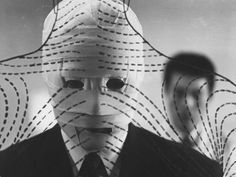
Two films about men who literally lose their faces take the full measure of the resulting ostracism and crushing isolation—and what men will do to escape it. Hiroshi Teshigahara’s The Face of Another (Tanin no Kao, 1966) is based on a Kobo Abe novel about a scientist named Okuyama who has been literally defaced by a chemical accident. We never see what he used to look like; he spends half the film swaddled in bandages like Claude Rains in The Invisible Man, ferocious black eyes glinting through slits. Obsessed with people’s reactions to his appearance, he lashes out bitterly, insisting that all his social ties have been severed, including his conjugal ties with his wife. She tries to convince him that it’s all in his head and that her feelings haven’t changed, but her revulsion when he makes an abrupt sexual advance convinces him that she’s lying.
Okuyama believes that a life-like mask will restore his relationship with his wife and his connection to society. He has evidently not seen The Face Behind the Mask (1941), a terrific B noir in which Peter Lorre stars as Johnny Szabo, who is hideously scarred in a fire. This tragedy and the ensuing cruelty of strangers transform him from a sweet, Chaplin-esque immigrant to a bitter criminal mastermind, even after he dons a powder-white mask that gives him a sad, creepy ghost of his former face—more Lorre than Lorre. The mask is merely a flimsy patch on the horrible visage that spiritually scars Johnny, and though it enables him to marry a sweet and loving (and perhaps near-sighted) woman, it can’t reverse the corrosion of his character.
The doctor who makes a far more sophisticated mask for Okuyama does so because the project fascinates him as a psychological and philosophical experiment. He speculates about what the world would be like if everyone wore a mask: morality would not exist, he argues, since people would feel no responsibility for the actions of their alternate identities. (His theory seems to be borne out by the consequences of internet anonymity.) Unlike the one Johnny Szabo wears, here the mask bears no resemblance to Okuyama’s original looks, and the doctor believes the new face will change his patient’s personality, turning him into someone else.
When the mask is fitted, it turns out to be the face of Tatsuya Nakadai, one of the most striking and plastic pans in cinema history. With only a little help from a fake mole, dark glasses, and a bizarre fringe of beard, Nakadai succeeds in making his own features look eerily synthetic, as though they don’t belong to him. Sitting in a crowded beer hall on his first masked outing in public, he creates a palpable sense of unease, keeping his features unnaturally still as though unsure of their mobility, touching his skin gingerly to explore its alien surface. As he gradually grows more comfortable and revels in the freedom of his new face, the doctor tells him, “It’s not the beer that’s made you drunk, it’s the mask.”
Abe’s novel contains a scene in which the protagonist goes to an exhibit of Noh masks, highly stylized crystallizations of stock characters and emotions. In Noh, as in other traditional forms of theater that use masks, the actor is present on stage but vanishes into another physical being—men play women, young men play old men, gods, and ghosts. In cinema, actors impersonate other characters using their own faces—usually without even the heavy layer of makeup worn on western stages. Movie actors are pretending to be people they’re not, yet if we judge their performances good it means we believe what we see in their faces. When an actor’s real face plays the part of a mask, like Lorre’s or Nakadai’s, this strange inversion—the real impersonating the artificial—has a uniquely disconcerting effect.
At the heart of this disturbing film lurks a horror that changing the skin can indeed change the soul. Okuyama tries to hold onto his identity, insisting, “I am who I am, I can’t change,” but the doctor insists he is “a new man,” with “no records, no past.” In covering his scar tissue with a smooth, artificial skin he eradicates his own experience, and with it his humanity. The doctor turns out to be right when he predicts that the mask will have a mind of its own. Suddenly endowed with sleek good looks, Okuyama buys flashy suits and sets out to seduce his own wife. When he succeeds easily, he is outraged, only to have her reveal that she knew who he was all along. After she leaves him in disgust he descends into madness and random violence. He has become the opposite of the Invisible Man: a visible shell with nothing inside
Okuyama’s story is interwoven with a subplot about a radiation-scarred girl from Nagasaki, whose social isolation drives her to incest and suicide. Lovely from one side, repellent from the other, she looks very much like the protagonist of A Woman’s Face. Ingrid Bergman starred in the Swedish original, but Joan Crawford is ideally cast in the 1941 Hollywood remake directed by George Cukor. Half beautiful and half grotesque, half hard-boiled and half vulnerable, Anna Holm spells out what was usually inchoate in Crawford’s paradoxical presence. A childhood fire has left her with a gnarled scar on one side of her face, like a black diseased root growing across her cheek and distorting her eye and mouth. Crawford makes us feel Anna’s agonizing humiliation when people look at her, which spurs her compulsive mannerisms of turning her head aside, lifting her hand to her cheek, or pulling her hair down.
Also perfectly cast is Conrad Veidt as the elegant, sinister Torsten Baring. Veidt went from German Expressionist horror—playing the goth heartthrob Cesar in The Cabinet of Dr. Caligari and the grotesquely disfigured yet weirdly alluring hero of The Man Who Laughs—to an unexpected late-career run as a sexy leading man in cloak-and-dagger films such as The Spy in Black and Contraband. When Anna turns her head defiantly to reveal her scar, Torsten gazes at her with a gleam of excitement, even of perverse attraction. She is confused and touched by his kindness and gallantry, helplessly trying to hide her sensitivity beneath a tough façade. Her broken-up, uncertain expressions when he gives her flowers or kisses her hand count as some of the most delicate acting Crawford ever did. Anna assumes that Torsten, the penniless scion of a rich family, must want her to do some dirty work, and she turns out to be right, but he also genuinely appreciates the proud, bitter, lonely woman who faces down her miserable lot through sheer strength of will.
People are horrible to Anna, nastily mocking her wounded vanity and her attempts to look nice. “The world was against me,” she says, “All right, I’d be against it.” She has found the perfect outlet, blackmailing pretty women who commit adultery. In one of the film’s best scenes, the spoiled and kittenish wife she is threatening retaliates by shining a lamp in Anna’s face and laughing at her. Anna leaps at the woman and starts hitting her over and over, forehand and backhand, in an ecstasy of hatred. This savagely satisfying moment is derailed by the film’s first grossly contrived plot twist, as the encounter is interrupted by the woman’s husband, who happens to be a plastic surgeon specializing in correcting facial scars. He offers to operate on Anna, and once the bandages are removed, in a scene orchestrated for maximum suspense, an absurdly flawless face is revealed.
The doctor (Melvyn Douglas) calls her both his Galatea and his Frankenstein: he views her as his creation, but isn’t sure if she’s an ideal woman or an unholy monster, “a beautiful face with no heart.” Her dilemma is ultimately which man to please, whose approval to seek: the doctor who believes her character should be corrected now that her face is, or Torsten, who wants her to kill the young nephew who stands between him and the family estate. This overwrought turn is never plausible; it is always obvious that Anna is no child murderer. What is believable is her erotic thrall to Torsten, the first man who has ever shown an interest in her. Crawford is at her most unguarded in these moments of trembling desire; Cukor remarked on how “the nearer the camera, the more tender and yielding she became.” He speculated that the camera was her true lover.
Anna undergoes months of pain and uncertainty for the chance of being beautiful for Torsten, and there is a marvelous shot of her gazing at herself in a mirror as she prepares to surprise him with her new face, brimming with hard proud joy. But he winds up lamenting the surgery that has turned her into “a mere woman, soft and warm and full of love,” he sneers. “I thought you were something different—strong, exciting, not dull, mediocre, safe.” In this same speech, Torsten reveals himself as a cartoonish fascist megalomaniac, which fits in with the film’s slide into silly, flimsily scripted melodrama, but sadly obscures the radical spark of what he’s saying. Anna’s character is shaped by the way she looks, or rather by the way she is looked at by men; the disappointingly conventional ending sides with the man who equates flawless beauty with moral goodness, and against the one man who was able to see something fine—a “hard, shining brightness,” in a woman’s damaged and imperfect face.
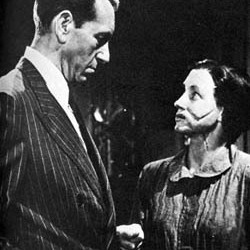
A Stolen Face (1952) follows a similar premise, much less effectively, and reaches the opposite conclusion. Paul Henreid plays a plastic surgeon who operates on female criminals with disfiguring scars, convinced that once they look normal they will become contented law-abiding citizens. He gets carried away, however, sculpting one patient into a dead ringer for his lost love (Lizabeth Scott plays both the original and the copy) and marrying her. His attempt to play Pygmalion backfires, since the vulgar, mean-spirited and untrustworthy ex-con is unchanged by her new appearance: she is indeed “a beautiful face without a heart.” That is a succinct definition of the femme fatale, a type Lizabeth Scott often played and one that embodies a fascination with the deceptiveness of feminine beauty. In The Big Heat (1953), it is only when Debbie (Glora Grahame) has her pretty face rearranged by a pot of scalding coffee that she abandons her cynical self-interest to become an avenging angel, fearlessly punishing the corrupt who hide their greed behind a genteel façade. She has nothing left to lose; pulling a gun from her mink coat and plugging the woman she recognizes as her evil “sister,” the disfigured Debbie asserts her freedom: “I never felt better in my life.”
Blessings in Disguise
Sometimes, people are only too happy to lose their faces. Dr. Richard Talbot (Kent Smith), the protagonist of the superb, underappreciated drama Nora Prentiss (1947), sees the bright side when his face is horribly burned in a car crash. He has already faked his own death, sending another man’s corpse over a cliff in a burning car. In a neat bit of poetic irony, by crashing his own car he has completed the process of destroying his identity, and no longer needs to fear he’ll be recognized. Losing his face is a blessing in disguise—or rather, a blessing of disguise. But the disfigurement is also a visual representation of the corruption of his character: his face changes to reflect his downward metamorphosis with almost Dorian Gray-like precision.
Car crashes are a kind of refrain in the film. The doctor’s routine existence veers off course when a taxi knocks down a nightclub singer, Nora Prentiss (Anne Sheridan), across the street from his San Francisco office. Talk about a happy accident: the nice guy trapped in an ice-cold marriage to a rigid, nagging martinet suddenly has a gorgeous, good-humored young woman stretched out on his examining table. Nora may sing for a living, but her real vocation is dishing out wisecracks (her first words on coming to are, “There must be an easier way to get a taxi.”) When the doctor mentions a paper he’s writing on “ailments of the heart,” the canary, her eyelids dropping under the weight of knowingness, quips, “A paper? I could write a book.”
It’s hard to imagine a more sympathetic pair of adulterers, but the doctor is so daunted by the prospect of asking his wife for a divorce that it seems simpler to use the convenient death of a patient in his office to stage his own demise and flee to New York with Nora. It’s soon clear, though, that some part of him did die in San Francisco. Cooped up in a New York hotel room, terrified of going out lest someone spot him, the formerly gentle man becomes an irascible, rude, nervous wreck. When the faithful and incredibly patient Nora goes back to singing for Phil Dinardo (Robert Alda), the handsome nightclub owner who loves her, Talbot becomes hysterically jealous. Unshaven and hollow-eyed, he slaps Nora and almost kills Dinardo before fleeing the police and heading into that fiery crash. He becomes, as the film’s evocative French title has it, L’Amant sans Visage, “the lover without a face.”
When his bandages are removed, he is unrecognizable, wizened and scarred, his face a creased and calloused mask. His own wife doesn’t know him, and when Nora visits him in prison his damaged face, shot through a tight wire mesh, looks like something decaying, dissolving. He’s in prison because, in an even neater bit of irony, he has been charged with his own murder. He decides to take the rap, recognizing the justice of the mistake: he did kill Richard Talbot.
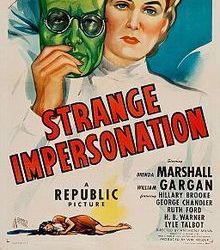
This same ironic plot twist appears in Strange Impersonation (1946), albeit less convincingly. This deliriously far-fetched tale, directed at a breakneck pace by Anthony Mann, stars Brenda Marshall as Nora Goodrich, a pretty scientist whose glasses signal that she is both brainy and emotionally myopic. She is harshly punished for caring more about work than marriage: her female lab assistant, who wants to steal Nora’s fiancé, tampers with an experiment so that it explodes, burning Nora’s face to a crisp. Embittered, she retreats from the world, and when another woman, who is trying to blackmail her over a car accident, falls from the window and is mistakenly identified as Nora, she seizes the opportunity to disappear, have plastic surgery that miraculously eliminates her scars, and return posing as the blackmailer, to seek revenge. She goes to work for her former fiancé, who strangely fails to recognize her voice or her striking resemblance to his lost love.

The plot plays out as, and turns out to be, a fever dream, but this last credibility stretcher is too common to dismiss as merely the flaw of one potboiler. Plots involving impersonation and identity theft rely not only on unrealistic visions of what plastic surgery can achieve, but on the assumption that people are deeply unobservant and tone-deaf in recognizing loved ones. A film that underlines this blindness with droll irony is The Scar (a.k.a. Hollow Triumph and The Man Who Murdered Himself, 1948), a convoluted but hugely entertaining little B noir in which Paul Henreid plays dual roles as a crook on the run and a psychologist who happens to look just like him. John Muller, pursued by hit men sent by a casino owner he robbed, stumbles across his doppelganger and decides to kill him and take his place. All he needs to do is give himself a facial scar to match the doctor’s. Only as he is dumping the body does he notice that he has put the scar on the wrong cheek—the consequence of an accidentally reversed photograph. But the irony quickly doubles back: Muller decides to brazen it out, and in fact no one notices that the doctor’s scar has apparently moved from one side of his face to the other—not even his lover. (Joan Bennett glides through this awkward part in a world-weary trance, giving a dry-martini reading to the script’s most famous lines: “It’s a bitter little world, full of sad surprises.”) The assumption that people pay little attention to the way others look or sound seems directly at odds with the power that faces and voices wield on film, and the intimate specificity with which we experience them. But noir stories often turn on how easily people are deceived, and how poorly they really know one another—or even themselves.
In The Long Wait (1954), perhaps the most extreme case of confused identity, a man with amnesia searches for a woman who has had plastic surgery. Not only does he not know what she looks like now, he can’t even remember what she used to look like. Since the movie is based on a Mickey Spillane story, he proceeds methodically by grabbing every woman he sees, in hopes that something will jog his memory. The film is fun in its pulpy, trashy way, provided you enjoy watching Anthony Quinn kiss women as though his aim were to throttle the life out of them. Quinn plays a man badly injured in a car wreck that erases both his memory and his fingerprints. This is lucky when he wanders into his old town and discovers he is wanted for a bank robbery—without fingerprints, they can’t arrest him. Figuring he must be innocent, he goes in search of the girlfriend who may or may not have grabbed the money and gone under the knife. It’s an intriguing premise, but the ultimate revelation of the right woman feels arbitrary, and the implications of all this confusion of identities are left resolutely unexamined. Nonetheless, there is something in the film’s searing, inarticulate desperation that glints like a shattered mirror.
Under the Knife
The promise of plastic surgery is a new and better self, the erasure of years and the traces of life. Taken to extremes, it is the opportunity to become a different person. Probably the best known plastic surgery noir is Dark Passage (1947), in which Humphrey Bogart plays Vincent Parry, who visits a back alley doctor after escaping from San Quentin. Parry was framed for killing his wife, so the face plastered across newspapers with the label of murderer has become a false face that betrays him. A friendly cabby who spots him recommends a surgeon who is he promises is “no quack.” Houseley Stevenson’s gleeful turn as the back-alley doctor is unforgettable, as he sharpens a straight razor while philosophizing about how all human life is rooted in fear of pain and death. He can’t resist scaring Parry, chortling over what he could do to a patient he didn’t like: make him look like a bulldog, or a monkey. But he reassures Parry that he’ll make him look good: “I’ll make you look as if you’ve lived.”

During the operation, Parry’s drugged consciousness becomes a kaleidoscope of faces, all the people who have threatened or helped him swirling around. His face is being re-shaped, as his life has already been shaped by others: the bad woman who framed him and the good woman who rescues and protects him, the small-time crook who menaces him and the kind cabby who helps him. Faceless for much of the movie, mute for part of it (he spends a long time in constraining bandages), Vincent Parry is among the most passive and cipher-like of noir protagonists. When the bandages finally come off after surgery, he looks like Humphrey Bogart, and the idea that this famously beat-up, lived-in face could be the creation of plastic surgery is perhaps the film’s biggest joke. But Vincent Parry remains an oddly blank, undefined character, and he seems unchanged by his new face and name. In a sense the doctor is right: he only looks as though he’s lived.
The fullest cinematic exploration of the problems inherent in trying to make a new life through plastic surgery is Seconds (1966), John Frankenheimer’s flesh-creeping sci-fi drama about a mysterious company that offers clients second lives. For a substantial fee, they will fake your death, make you over completely—including new fingerprints, teeth, and vocal cords—and create an entirely new identity for you. There is never a moment in the movie when this seems like a good idea. The Saul Bass credits, in which human features are stretched and distorted in extreme close-up, instills a horror of plasticity, and disorienting camera-work creates an immediate feeling of unease and dislocation, a physical discomfort at being in the wrong place.
Arthur, a businessman from Scarsdale, is the personification of disappointed middle age, afflicted by profound anomie that goes beyond a dull routine and a tired marriage. When the Company finishes its work—the process is shown in gruesome detail, to the extent that Frankenheimer’s cameraman fainted while shooting a real rhinoplasty—the formerly nondescript and greying Arthur looks like Rock Hudson, and has a new life as a playboy painter in Malibu. He’s told that he is free, “alone in the world, absolved of all responsibility.” He has “what every middle-aged man in America wants: freedom.”

At first, however, his life proves as empty and meaningless in this new setting as it was in the old; even when the Frankenstein scars have healed, he remains nervous and joyless as before. After he meets and falls for a beautiful blonde neighbor, who introduces him to a very 1960s California lifestyle, he begins to revel in youth and sensual freedom. Yet something is still not right; at a cocktail party he gets drunk and starts talking about his former existence—a taboo. He discovers that his lover, indeed almost everyone he knows, is an employee of the company or a fellow “reborn,” hired to create a fake life for him, and to keep him under surveillance. His “freedom” is a construct, tightly controlled.
Arthur rebels, making a forbidden trip to visit his wife, who of course does not recognize him. Talking to her about her supposedly deceased husband, for the first time he begins to understand himself: the depth of his alienation and confusion, the fact that he never really knew what he wanted, and so wanted the things he had been told he should want. Seconds is a scathing attack on the American ideal of a successful life, a portrait of how corporations sell fantasies of youth, beauty, happiness, love; buying into these commercial dreams, no one is really free to know what they want, or even who they are. Will Geer, as the folksy, sinister founder of the Company, talks wistfully about how he simply wanted to make people happy.
There is a deep sadness in the scenes where Arthur revisits his old home and confronts the failure of his attempt at rebirth—beautifully embodied by Rock Hudson in a performance suffused with the melancholy of a man who has spent his life hiding his real identity behind a mask. Yet Arthur still imagines that if he can have another new start, a third face and identity, he will get it right. Instead, he learns the macabre secret of how the Company goes about swapping out people’s identities. Seconds contrasts the surgical precision with which faces, bodies, and the trappings of life can be remade, and the impossibility of determining or predicting how or if the inner self will be changed. For that there are no charts or diagrams, and no knife that can cut deep enough.
by Imogen Sara Smith
10 notes
·
View notes
Text
Full PlayLew: Kingdom Hearts
hey so it’s been a while since i really wrote anything about games but recently i bought the Kingdom Hearts HD 1.5 + 2.5 - ReMix - collection (not to be confused with Kingdom Hearts 2.8 Final Chapter Prologue you silly goose) which is a collection of Kingdom Hearts, Re:Chain of Memories, Kingdom Hearts II, Birth by Sleep and full cinematics for the two early DS games...that’s a lot of Kingdom Hearts...and because i only owned my first PS2 in 2013, i missed out on the whole Kingdom Hearts shabang! so let's document my first playthrough of the game that started it all; Kingdom Hearts! depending, i might write up a post about all the games as i play them and tell you all what a Birth by Sleep is but for now, let’s keep this Simple And Clean and start with the first game
(warning: spoilers for the game and full on rambling)
So there's a reason why I wanted to get into Kingdom Hearts, asides from Millenial Peer Pressure to understand what Simple And Clean means, cus there's one cutscene I saw from the second game where Goofy gets smacked with a rock and Mickey Mouse in a super hot topic zipped jacket gets really upset and the entire scene is both super melodramatic and absurd at the same time and I REALLY liked that. I really liked the idea of this crossover series from the two biggest giants of it's day, just going 100% extra and hopefully taking its premise to the next level...and it does.
Like, one of the first things you do in this game is meet Wakka from FFX and smack him with a wooden sword and there's a cutscene not further on where Aerith is having a serious discussion with Goofy and Donald Duck about a metaphorical darkness and...it's great. i'm going on about this aspect so much immediately because it's my favourite part of the game. the charm and the balance of touching tribute and ridiculous revelations that Kingdom Hearts achieves with merging its properties.
The actual game itself isn't the showstopper here but it's still worth talking about. It plays like a third person action game where you have all the bearings of it's Final Fantasy brethren with random encounters, leveling up, a party system and summons but the game doesn't load in and out of battles, you just get straight into a brawl on the map and there's no turn based battle system. I gotta give the team credit for wanting to make a different combat system than a lot of similar JRPGs at the time because it really helps give the series its own identity from minute one, with both the system and the keyblade weapon that you use to melee and cast spells with. At first it can be a bit jarring and hard to play. Sometimes the camera feels too tight behind Sora (the dude you play as) and processing the 3D space between you and the enemy can be a bit difficult to judge. Also the tightness means you'll get hit by off-screen attacks quite a bit more than you'd feel fair but once you start to get the hang of fighting through tough battles and slowly gain new spells, like a self heal, and a fuckin roll (!), it starts to click and becomes an enjoyable fighting system. The enemy variety in the game could've been upped to keep it more interesting in the later stages but it feels satisying to blow enemies UP with your keyblade (god I love the keyblade's design so much)...and it's hard not to admit the satisfaction of the one-on-one rival battles. When you're up against a dude the same size as you and he's got a melee weapon as well...it is Fire 100 Turn Up The BBQ.
It's a shame that those type of boss fights only really appear near the end because, for the first half at least, the boss fights aren't too great. The worst boss fights that show up in this game are the ones where the hurtbox of the enemy is on a head or a high part of their body, so as Sora you have to jump up and do an air combo at their hurtbox, hoping the hits connect or that you get your full combo out or the enemy doesn't move as you're jumping or the enemy just doesn't knock you out of it...but most of the time that stuff happens and it makes those boss fights some of the most annoying and unsatisfying. There's one boss fight in perticular, at the end of the Wonderland level, which is pretty much the first proper level of the game, that is really tall and his hurtbox is his main body which is propped up on two huge legs and trying to HIT IT is so tough. If you're on the ground, you have to make sure to jump and start attacking at the height of your combo otherwise you'll hit his legs which means that your attacks will literally bounce off him and you'll be flung to the ground. Even when I did get hits in on his body from jumping off the ground, i'd usually only get one or two hits in before I just hit the ground again and...that's not fun! There's a table in the middle of the arena you can climb onto that gives you a platform to jump off and smack him with but ONE that's just as annoying. having to keep climbing up this table to get three or four hits in, fall to the ground and repeat is bad and TWO the table is destructible by the boss! So he can just destroy it and make it even more annoying! Also he takes reduced damage from the 1 out of 2 spells you have at that time. Ahhhhh!!! And whilst no other boss comes close to being as annoying as that, there's still other bosses that use some of it's Anti-Fun Kata Techniques and they can be pretty unsatisfying.
Also some of the worlds in this game can be hit or miss. In Kingdom Hearts you travel between levels that, at most times, are Disney themed worlds like Neverland, Pumpkin Town and Olympus Collesium. Some of them are literally just 3 or 4 rooms, some are bland and some are downright barbaric like the Tarzan level that makes you travel up and down the level several times to trigger new cutscenes or events to progress the story and it can get really frustrating ESPECIALLY when the game doesn't make it all that clear where you need to go or what you have to do, so you're just hopelessly running around, entering in and out of buildings hoping something changes!
So okay, i've talked about what didn't work in this game BUT worry not, positive vibes are coming in the form of my early point; presentation! The game is a Disney and Final Fantasy crossover and the game's use of those licenses helps prop the game up massively. The Wonderland level, whilst not the most interesting level design wise, is propped up massively by just the very idea of it being Wonderland and everything that comes with it. Fun, colourful imagery! Gimmicks involving being huge and small! Twisted geometry spaces! A purple talking cat! Like the way they use their licenses to create these distinct, colourful, imaginative worlds with a diverse set of characters feels like cheating since they're using already existing brands but it's no lie that this all helps create a game that really feels like you're playing on this large Disneyland rollercoaster that shows you the world! And you're not just going by saying “I recognise the thing! I clapped!”, you're fuckinnnng in the thing! You're interacting with all the things! Sometimes you even kill the things and just twisting the properties onto their heads! Remember that time Clayton from Tarzan got fucking killed by a chameleon crushing him?? Yeah! Me too! It's rad!! Remember that time Hades from Hercules hired Cloud to kill you?? Yeah!! That's what makes this whole thing feel fun and worthwhile and not a simple nostalgia grab or whatever. Cus Disney gave them full license to do whatever they wanted and guess what W E D O I T said Nomura.
I also love how in certain worlds, aesthetics or even entire systems will change to match it. Like how in Little Mermaid level, you play it completely underwater. They could have made you stick to the bottom of the seabed and play it like a normal level or put you in a sub or whatever but they didn't, instead they change Sora and your parties models so you're a mermaid and you have to instead move using square and circle to go up and down through the water. That's cool! In the Neverland level, you get to fly like Peter Pan through the level and fighting flying pirate ships in the sky as you float is wonderful! And the part at the end where you go to a city level and you fly around the equivalent of Big Ben as the music swells up is one of my highlights from the game...cus it just FELT good in my hands. Even the smaller changes like Sora getting a new, gothed up, halloween costume for the Nightmare Before Christmas level is a cute touch! In a perfect world all of these changes would have happened for the majority of levels but alas.
There's also this Winnie the Pooh world that's probably my favourite. At a part of the game, you get a book that you can access and as you open the book, you find yourself walking around 100 Acre Woods and meeting Winnie the Pooh but the rest of the pages are missing. So as you go through levels, you find these pages for the book and for each page you get a new level of 100 Acre Woods that feels like a light, adventure where you're hanging around with Winnie the Pooh and friends. There's no combat in the levels, it's all just mini-games and talking with Pooh and the cast...and it's wonderful. Not only does it fit the tone of the license, cheerful fun, but the feel of the level from the writing and the adventures just feels...Pooh-like. And then when you get that last page and you get Pooh and all his friends together and they bid you farewell and the book closes to show a picture of Sora holding hands with Pooh...i got emotional man...i really did.
And then there's the other side of the spectrum, from fighting off tears over a really well done, careful use of it's properties to grinning like mad with tears of laughter at the ridiculous use of its property. Okay so like the end of the game is, the greatest. After you defeat the main bad guy (he was a scientist trying to use darkness for power blah blah), you get this scene where Sora and friends find the door to the Kingdom Hearts! The source of all hearts! And in it there are Heartless (the enemies) coming out of it so you have to go and close the door BUT doing it on your own isn't enough so you have to use the help of your friend Riku (he was a friend-turned-rival-turned-back to friend by the end)to shut it BUT! He has to shut it from the other side of the door which means locking himself in with the Heartless and the darkness within it. So he's basically gonna get fucked. And Sora realises this and after refusing to shut the door at Riku's request, he obliges and in an emotional moment goes to push it shut….BUT SHUT THE FUCK UP, DONALD DUCK PEEKS IN THE DOOR AND GOES “WUHHHHH” AND YOU NOTICE MICKEY MOUSE'S ICONIC EARS AND HEAD CAST A SHADOW AND IN AN EXTREMELY MICKEY MOUSE VOICE GOES “HEY SORA!” AND IT'S LIKE FUCKING AWESOME. FUCKING GREAT. EMOTIONAL MOMENT -DEFUSED-, PREY SLAUGHTERED CUS MICKEY MOUSE TALKED. I couldn't stop laughing the whole time and then mickey mouse shuts the door and all is saved. BUT THEN because of complications, Sora has to leave behind his childhood sweeheart Kairi that he saved to go back to her world whilst Sora gets left behind in wherever he is and then Simple And Clean, the main theme, just blast with its cheesy super early 2000's musical sheen as a closing FMV plays where Kairi is crying about missing Sora and everyone is all happy cus they get to see their friends again and it's so...innocent and perhaps naive at what it's doing but it fills me life man. I was singing the lyrics to this RnB track as I thought about the events that just occurred and seeing Pinnochio turn into a real boy and Cloud meet back up with Aerith and maaaaaaaan
That's why I really like Kingdom Hearts. The gameplay is generally fun despite some dips, there's some rewarding treasure hunts despite the level design being bland….on a purely Game perspective, it isn't that special and is probably worse than other 3D platformers of it's time BUT where it really shines and where the charm gets to me in this game is just how much it celebrates and lets you engage with it's crossover. Whether it's trying to evoke a feeling of sadness at a childhood gone by or drama through laughable scenarios involving Disney and Square Enix characters...it's just got real charm and i'm so happy this game exists. I'm even happier that it was successful enough to spawn an entire franchise that still has young kids and grown adults getting hyped for it's next installment. It's a weird kinda magic that I don't think any other game or series has fully replicated. Will the charm wear off I play through more and more of these games? I dunno, we'll see...but for now, Kingdom Hearts, thank you for being really Goofy.
P.S: Simple And Clean is so good
1 note
·
View note